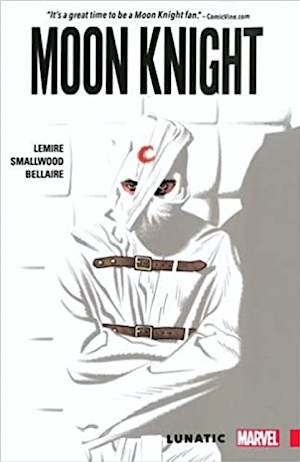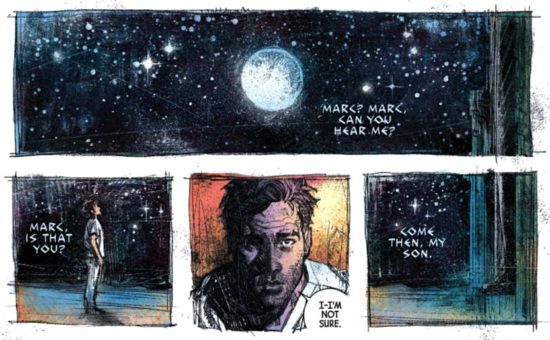Real or Imagined Lives: Teaching Moon Knight
Dr. Jason DeHart is an assistant professor of reading education at Appalachian State University in Boone, NC. He currently teaches courses in middle school language arts methods and adolescent literacy.
The Marvel character Moon Knight, arguably a third-tier or lesser-known antihero within the comics universe where names like Captain America and Iron Man are far more well-known, has recently been brought to public attention by the so-named Disney Plus series.
While a number of comics treatments of Moon Knight are quite violent, I highlight Part 1of Jeff Lemire’s graphic novel series, titled Lunatic and illustrated by Greg Smallwood which (while still disturbing to some) is less so.
It should be noted that the pejorative “lunatic” can be reframed and reconsidered when working through the text. Mental health concerns continue to carry a stigma in our society, and literature (including graphic novels) can be a powerful vehicle for talking about real-life issues. While Marc Spector/Moon Knight struggles to find his place in the imaginary world of the Marvel universe, a number of students are engaged in negotiating very real challenges in life.
Teachers can proceed with care and sensitivity as they discuss the unfolding narrative in Lemire’s story collection. The complete series (Nos. 1-14) is available in paperback at Amazon and Barnes & Noble and is labeled for “8th grade and above – Ages 13-18.” You can sample the Kindle version of the first issue here.
Creating Empathetic Spaces for the Superhero Within
First, the nature of the Marc Spector character can be explored and noted. Spector began as a villain and was reconfigured as a hero due to his popularity. His dual identity (a cabbie named Jake Lockley) was invented as a way of explaining how he knew that crimes were happening. Unlike other heroes who just happen upon danger in progress, Spector/Lockley scoured the streets to find avenues for heroism.
Further complicating his origin, but also adding a level of intrigue, Spector is the avatar of the Egyptian moon god, Khonshu. It is no small wonder that actor Oscar Isaac portrayed this character with so many dimensions (rather well, I might add) in the Disney+ version.
Writer Jeff Lemire’s contribution to the storyline is the blending of fantasy and reality. In previous incarnations Moon Knight was either a violent avenger or quite literally a member of the Avengers (West Coast branch). His affiliation with the West Coast Avengers was my first engagement with the character, along with a trading card representation.
Spector/Lockley also has a third identity, Steven Grant. This aspect of the character is a movie star/billionaire, responsible for the gadgets and tools that Moon Knight has in his arsenal. Apparently, Tony Stark, a.k.a. Iron Man, was too busy (or concerned) to invest. These demands of the character’s life build causal links that can be discussed in terms of character development. While narratives take different shapes in this story, Lemire paints Spector as a character with possibilities for building empathy.
One does not need a range of mythological identities to consider that we all have parts of who we are, including experiences and ways of engaging with the world. Teachers can use this narrative to talk about the hero within, that person we are based on with the aspects of our experiences and personality, as well as the strengths that each of us brings as part of a learning community.

Reading Characters and Settings Closely
Since Spector presents so many avenues of identity, students can work with their teacher to trace the course of the narrative, from the asylum setting to the outer cosmos. In later issues, the world literally turns upside down and the reader has to flip the page to get a full sense of the action as Moon Knight attempts to grapple with the demands of his reality.
Mythology deities populate this universe, and a flashback sequence gives foundation and food for thought as to why Spector might be a troubled hero. As with all comics, the affordances of a visual text can lead to close reading of emotions contained in the images.
This is the kind of work that requires an additional step of visualizing in prose as well as translating words. Comics include a sense of access in this way across languages and in spite of where a reader is in their literacy development.
Teachers can pause to take in images, consider characters, and build discussion around both the real and fantastic elements of the story – hopefully inspiring young creators to respond both in classroom discussion and in their own comics writing/drawing/making. Even the contrast between the constrained Spector on the cover of the first issue and the opening pages across an astral and mystical plain set up a dichotomy that is ripe for exploration.
 Final Decisions about the Story
Final Decisions about the Story
It is this blend of the realistic and fantastic which leads to one of the most intriguing aspects of Lemire’s take on Moon Knight – and probably the reason why this rendition of the character is the one that resonates with me most.
As readers we encounter a potentially unreliable narrator. So, how do we trust a storyteller who may, indeed, not even fully trust themselves? Within the first few pages, Khonshu (the Egyptian God of the Moon and the Night Sky) appears in a kind of therapist role while Spector has left the astral plain.
Through the course of the narrative, we encounter hints that Spector’s world may be all of his own imagining. Is he truly the avatar of an Egyptian god, or is he just another silhouette in the pantheon of hysterical people who see themselves as something else? Is he really a superheroic avenger, or is this a product of his own mind?
Ultimately, as is the case with modern literature, the decision is ours and the debate over this can be a rich source of dialogue based on text evidence in the classroom space. We are left with questions that can be taken up and considered while rereading to expand our understanding.
When noting aspects of visual stories like comics, I am much more likely to annotate using sticky notes (even though I freely write on prose pages if they belong to me). I encourage a similar sense of marking and engagement by young readers, and adding words and thoughts is a helpful approach for wordless panels which require a close focus on the visual without words to lean on.
Conclusions
While comics may not be the immediate go-to for some teachers, they are a rich source of adolescent reader engagement. In the hands of a teacher who is willing to seize on all the parts of the text and linger with images to build conversations and invitations to composing with students, they have links to literacy instruction as well.
Moreover, normalizing therapy as a healthy part of life and speaking positively of seeking help from a wider community is an additional avenue of conversation for linking to social and emotional needs beyond the cool factor of the story.
As mentioned early on in this post, the Disney Plus series has focused attention on the Moon Knight character. I encourage teachers to consider the Lemire storyline, as well as the early stories of Marc Spector, allowing students to discuss and debate aspects of the narrative. Hero? Villain?
Either way, I am glad that his story is finally getting more attention.
Feature image credit: Screenrant.
Jason D. DeHart (@JasonDDeHart1) is an assistant professor of reading education at Appalachian State University. He taught 8th grade language arts for eight years in Cleveland, Tennessee. DeHart’s research interests include multimodal literacy, film and graphic novels, and literacy instruction with adolescents.
Jason’s work has appeared in SIGNAL Journal, English Journal, The Social Studies, and here at MiddleWeb, including a 3-part series with teacher and school librarian Jennifer Sniadecki on using picture books with middle level readers. See all of Jason’s MiddleWeb posts – including How Might We Teach a Graphic Novel? Series – here.



































